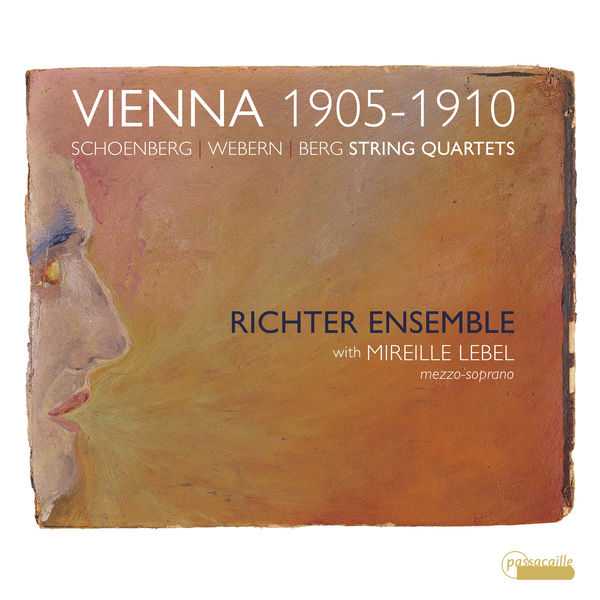

Composer: Alban Berg, Arnold Schoenberg, Anton Webern
Performer: Mireille Lebel, Richter Ensemble
Format: FLAC (tracks)
Label: Passacaille
Catalogue: PAS1093
Release: 2020
Size: 0.97 GB
Recovery: +3%
Scan: yes
Webern: String Quartet
01. Düster und schwer – Mit grossem Schwung – Langsam – Schnell – Sehr breit – Zart bewegt – Sehr langsam
Schoenberg: String Quartet No. 2, Op. 10
02. I. Mässig (Moderato)
03. II Sehr rasch
04. III. Litanei. Langsam, “Tief ist die Trauer”
Arnold Schoenberg, Stefan George: String Quartet No. 2, Op. 10
05. I. Entrückung. Sehr langsam, “Ich fühle Luft von anderem Planeten”
Berg: String Quartet Op. 3
06. I. Langsam
07. II. Mässig Viertel
The Richter Ensemble plays music from the 17th to the 20th century exclusively on gut strings and uses its experience with historical performance practice to sharpen the sense for the development of musical language over the centuries. It is passionately dedicated to the music of the Second Viennese School and, based on its research, has decided that the time is ripe to take the perception of this music in a new direction, on the path of rediscovery and recapture not only of its modernity but also of its connections to the past. For this reason, the musicians have initiated a project to record the complete string quartet works of the Second Viennese School, to place them in a historical context and to combine them with unusual works by other composers. Their first production is called Wien 1905-1910 and contains music by Webern, Schoenberg and Berg: Webern’s Slow Movement, Schoenberg’s String Quartet No. 2 with mezzo-soprano (as originally intended!) and Berg’s Opus 3. This approach captures a completely different palette of sounds and reveals a romantic language and nuances that are often overlooked in sometimes strictly modern string quartets with their metal strings. As a result, accessing these works is less of a challenge for the listener.
If the Richter Ensemble is a new name to you, then that’s because in the grand scheme of things it’s relatively new on the block, formed as recently as 2018 by British-Brazilian Baroque violinist and former Academy of Ancient Music concertmaster, Rodolfo Richter. Its other members are equally drawn from across the world of Historically Informed Performance, and while HIP credentials may not at first glance seem an obvious fit for a debut album of Second Viennese School repertoire, they actually point both to the group’s mission statement and its unique selling point – to highlight hidden connections between repertoire ranging from the seventeenth to the twenty first centuries, with all of that repertoire played exclusively on gut strings.
Back to the recording in hand, and this is the first installment of a project to record the complete Second Viennese School string quartets on gut strings, and it is very fine indeed. Repertoire-wise, they take us through chronologically, beginning with Webern’s ardent one-movement Langsamer Satz of 1905, couched in the language of late Romantic chromaticism; then Schoenberg’s String Quartet No. 2 of 1907-8, one of his first forays into atonality which features a mezzo soprano for its latter two movements setting poems by Stefan George; after which comes Berg’s two-movement String Quartet Op. 3 of 1910, equally exploring atonality.
Sound-wise, beyond super-glued chamber playing and wonderfully rich-toned and emotive vocal performances from mezzo Mireille Lebel, what really makes these interpretations stand out is the way they place the works in their immediate Viennese context: the fact that it wasn’t a hard-edged brand of modernism that was in everyone’s heads during these early ventures beyond tonality, but instead the music of Brahms, Mahler and Wagner; and all this amid a wider expressionist and symbolist artistic context that equally blended Romanticism and modernism – think of Gustav Klimt’s paintings. So, beyond the greater softness and wider coloristic palette offered by those aforementioned gut strings, we also get tonal sheen, subtle “portamentos”, and a singing freedom to their lines. We are also at a period pitch slightly lower than today’s standard: A=432Hz compared to the current 440Hz. Yet all this Romantic gorgeousness is still sounding clean as a whistle – just thanks to the nineteenth century practice of using vibrato only sparingly.
Even if Second Viennese School isn’t your usual bag, I urge you to give it a spin. This is likely to be a very covetable series indeed.